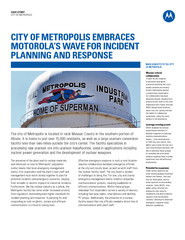PDF-CASE STUDY CITY OF METROPOLIS The city of Metropolis i
Author : danika-pritchard | Published Date : 2015-06-08
It is home to just over 15000 residents as well as a large uranium conversion facility less than two miles outside the citys center The facility specializes in processing
Presentation Embed Code
Download Presentation
Download Presentation The PPT/PDF document "CASE STUDY CITY OF METROPOLIS The city o..." is the property of its rightful owner. Permission is granted to download and print the materials on this website for personal, non-commercial use only, and to display it on your personal computer provided you do not modify the materials and that you retain all copyright notices contained in the materials. By downloading content from our website, you accept the terms of this agreement.
CASE STUDY CITY OF METROPOLIS The city of Metropolis i: Transcript
Download Rules Of Document
"CASE STUDY CITY OF METROPOLIS The city of Metropolis i"The content belongs to its owner. You may download and print it for personal use, without modification, and keep all copyright notices. By downloading, you agree to these terms.
Related Documents














